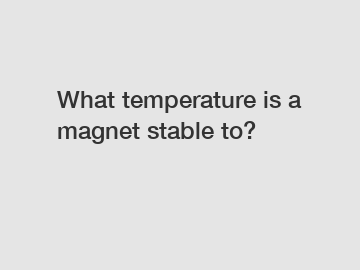What temperature is a magnet stable to?
What Temperature is a Magnet Stable to?
Magnetic materials are widely used in various industries and have proven to be an essential component in many devices. However, have you ever wondered what temperature a magnet can withstand? The answer to this question lies in the unique properties and behavior of magnetic materials under different thermal conditions.
When we talk about the stability of a magnet, we refer to its ability to retain its magnetic properties under extreme temperature variations. The temperature at which a magnet starts losing its magnetization is known as the Curie temperature. Above this critical temperature, the thermal energy disrupts the alignment of the magnetic domains, causing a decrease in the overall magnetic field.

The Curie temperature varies depending on the type of magnet and its composition. For common magnets like neodymium magnets, the Curie temperature is around 310°C or 590°F. This high upper temperature limit makes them suitable for applications in environments with elevated temperatures.
The stability of a magnet at high temperatures is crucial for various industries. For instance, in the automotive sector, magnets in electric motors must remain functional and maintain their magnetic properties under the heat generated during operation. Similarly, in aerospace applications, where vacuum environments and extreme temperatures are present, magnets are required to withstand such conditions to ensure proper functioning of critical components.
Magnetic materials, such as samarium cobalt magnets, have even higher Curie temperatures, reaching up to 800°C or 1472°F. These types of magnets find extensive use in high-temperature applications like microwave devices, sensors, and actuators.
To determine the Curie temperature of a particular magnet, scientists conduct careful experiments and measurements. They apply a magnetic field to the material and gradually increase the temperature while monitoring the magnetization. At the Curie temperature, a sudden drop in magnetization is observed, indicating the loss of magnetic properties.
Understanding the Curie temperature of magnets is essential in the design and selection of materials for various applications. Manufacturers can ensure that they choose the appropriate magnet type for specific temperature requirements, thereby avoiding potential performance degradation or failure due to excessive heating.
In conclusion, the Curie temperature determines the upper limit at which magnets maintain their magnetic properties. It varies based on the magnet's composition, with commonly used magnets having Curie temperatures of around 310°C. Knowledge of this critical temperature allows for informed decision-making in selecting the right magnet for different applications, ensuring their stability and functionality even under harsh thermal conditions.
If you want to learn more, please visit our website Precast Concrete Formworks Button Magnet, Neodymium Laminated Magnet, Reusable Magnetic Chamfer Strip.


